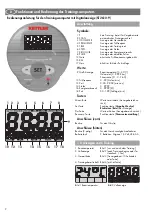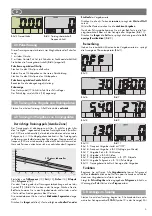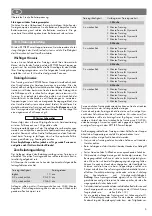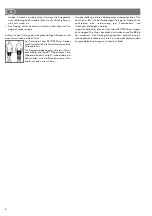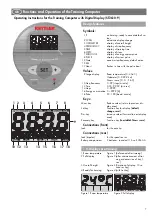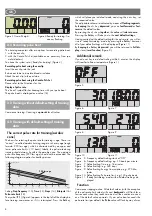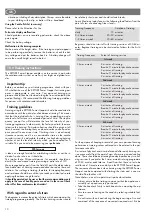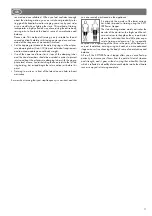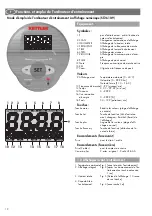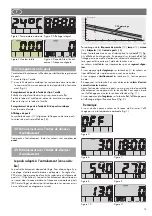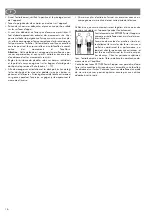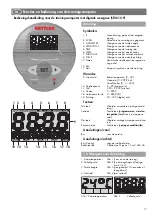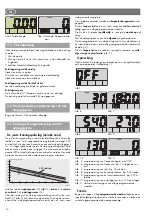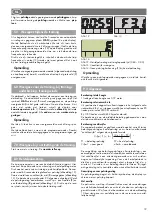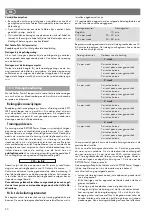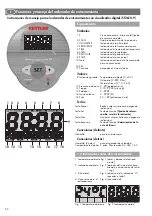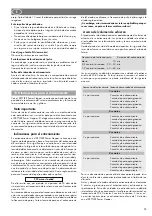
10
GB
vibration or shaking of any description. Always secure the cable
to your clothing with a clip, or better still to a headband.
Using the Cardio Puls Set (accessory)
Please refer to the Directions for Use.
Pulse-rate display malfunction
Should problems arise in recording pulse-rates, check the above
points again.
Check the battery voltage.
Malfunction in the training computer
Make a note of the height status. If the training computer appears
to be performing peculiarly, remove the batteries, check the bat-
tery voltage and put the batteries back in. A battery-change will
cause the overall height saved to be lost.
The KETTLER Power Stepper enables you to exercise in particular
the cardiovascular system as well as your thighs and gluteal mus-
cles.
Important tip
Before you embark on your training programme, check with your
GP whether the use of the KETTLER Power Stepper for training pur-
poses is appropriate in your case. Your personal training pro-
gramme should then be structured along the lines indicated by the
medical findings. We recommend the following training guidelines
for persons with cardiovascular disorders.
Training guidelines
Training using the KETTLER Power Stepper should be conducted in
accordance with the principles of endurance training. This means
that that the individual who is training does so applying a mode-
rate level of effort over an extended period of time. The step-fre-
quency you opt for will determine the level of intensity of your
training programme. In other words, the faster you climb, the more
intensive the training. Particular attention should be given at all
times, however, to ensuring that you do not overtax yourself and ex-
pose yourself to excessive strain. Climbing stairs is an extremely
strenuous exercise, and it is a considerable strain on the cardio-
vascular system. It is advisable, therefore, to check during training
whether or not the level of intensity which you have opted for is
suitable. This you can do by measuring your
pulse rate
.
is taken as a rough formula for establishing whether or not the in-
dividual’s pulse rate is as it should be.
This implies that a 50-year-old person, for example, should con-
duct his/her endurance training assuming a pulse rate of 130.
Many recognised experts from the field of Sports Medicine take a
favourable view of training recommendations based on these cal-
culations. Your settings in training, therefore, for stepping frequency
and resistance should be such that you reach your ideal pulse rate
applying the above rough formula.
I
t should be pointed out, however, that these recommendations only
apply in the case of healthy persons and not in the case of those
who suffer from cardiovascular disorders!
With regard to extent of strain
The beginner increases the extent of strain which accompanies the
training programme gradually. The first few training sessions should
220 less age
10.0 Training instructions
be relatively short ones and should include breaks.
Sports Medicine today favours the following load factors from the
point of view of enhancing fitness levels:
Beginners should not start off with training sessions of 30-60 mi-
nutes. Beginner training can be structured as follows for the first 4
weeks:
For the purpose of keeping a record of your own personal training
performance, training values achieved can be entered in the per-
formance schedule.
5 minutes of physical exercises before and after each training ses-
sion prove useful from the point of view of warming up and cooling
down. There should be one training-free day between any two trai-
ning sessions if you prefer the 3-times-a-week training programme
of 20-30 minutes each later on. Apart from that, there’s a lot to be
said for one 10-minute session daily on the KETTLER Power Stepper.
The sequence of movements when training using the KETTLER Power
Stepper can be compared with climbing the stairs and is one we
should all be familiar with.
Nevertheless, one or two points merit particular attention:
• Always ensure before training commences that the appliance is
correctly set up and securely positioned.
• Take the handrails firmly in both hands when mounting the ap-
pliance.
• Ensure a secure footing on the treads by selecting suitable foot-
wear.
• Do not train with no hands during the beginner stage. A sound
command of the sequence of movements required must first be
Training frequency
Duration of training
daily
10 minutes
2–3 times a week
20–30 minutes
1–2 times a week
30–60 minutes
Training frequency
Extent of training session
3 times a week
2 minutes of training
Break of 1 minute for physical exercises
2 minutes of training
Break of 1 minute for physical exercises
2 minutes of training
3 times a week
3 minutes of training
Break of 1 minute for physical exercises
3 minutes of training
Break of 1 minute for physical exercises
2 minutes of training
3 times a week
4 minutes of training
Break of 1 minute for physical exercises
4 minutes of training
Break of 1 minute for physical exercises
3 minutes of training
3 times a week
5 minutes of training
Break of 1 minute for physical exercises
4 minutes of training
Break of 1 minute for physical exercises
4 minutes of training
4th week
3rd week
2nd week
1st week


